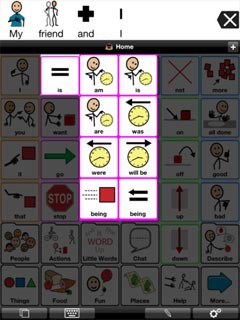

Proloquo2Go is a user friendly app and adding new vocabulary is straight forward. It gave him more chances to interact with other students. It allowed him to ask for his turn in a game and tell another child to follow an instruction in a game. Having the app allowed Mohamed request for items he wanted and to comment on different topics. This meant that he would hand over a picture of an item he wanted as a means to ask for it. Before he started using the app he made his needs known by using picture exchange. I used Proloquo2Go with a seven year old boy, Mohamed, who had apraxia of speech alongside a diagnosis of autism. It gave her a way to stay included in conversation and helped with developing her sentences. This made it easier for others to understand her when she spoke. When we worked on answering questions the app acted as a visual prompt initially and also provided a spoken model to Fatima which she could copy. Fatima used words to communicate but her articulation difficulties made it very difficult for other people to understand her. Most recently I worked with a teen-ager, Fatima, who used the device to make requests and put short sentences together to communicate with her friends.

I have used Proloquo2Go with verbal and nonverbal students. to add vocabulary related to a new game or group activity at school or out in the community.
It can be updated quickly to support a child in a new communication setting e.g. This allows more realistic pictures to be used. There is often a choice of picture symbols that can be used if you run a search on a key word e.g. You can save templates on the page set up- which allows certain buttons to always be accessible e.g. This means that the iPad can be solely used for communication purposes rather than being used alongside other functions e.g. The settings on the iPad allow you to lock use of the iPad to the Proloquo2 app. You can add text to the pictures/ buttons on the screen – which supports phonological awareness and literacy. You can take photos and add them to the app. This helps support sentence formulation skills. pronouns in yellow, action words in green. #PROLOQUO AUTISM CODE#
You can colour code different icons according to their category e.g. This means that as your child becomes more familiar with the app/ their comprehension skills improve you can increase the number of buttons/ pictures that you present to them on the interface. You can select the number of buttons that are put on the page. 
favourite songs, movies, stories and jokes. Different interests can be grouped according to category e.g.

This makes it easier to speak about relevant people in that person’s life.
It is highly personalized- the users family and friends pictures can be taken and added to the app as buttons. requesting items, requesting help, attention or a break from an activity, requesting to use the toilet, refusing an item that is offered. It allows functional communication needs to be met e.g. Some other positive features with this app are: I’ve used it to work on requesting (asking for things a child wants), labelling, forming sentences and answering questions. Proloquo2Go is a communication app that can be downloaded and used across most platforms. I’ve used ‘Proloquo2Go’ with a number of children over the last few years. Selecting your child’s voice is an important decision! It’s nice to give parents a couple of options. I’m always on the lookout for new apps that will support communication. They have become cheaper and more accessible for parents and families. Nowadays communication apps can be purchased and used on iPads. Previously a communication device may have cost in the region of 10,000 USD. They often have an interface with buttons/ icons that a student presses and the device speaks out a word or sentence when pressed.Īdvances in technology have made communication devices more easily available and accessible to parents and families. Communication devices are types of equipment (often in tablet form) that assist an individual to interact with others. Of the 75% who use verbal/ vocal communication many struggle with using language spontaneously and to initiate communication in social interaction. It’s estimated that approximately 25% of individuals with autism are non verbal.








 0 kommentar(er)
0 kommentar(er)
